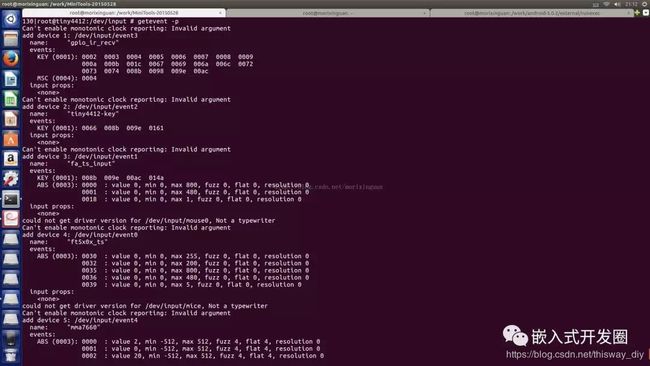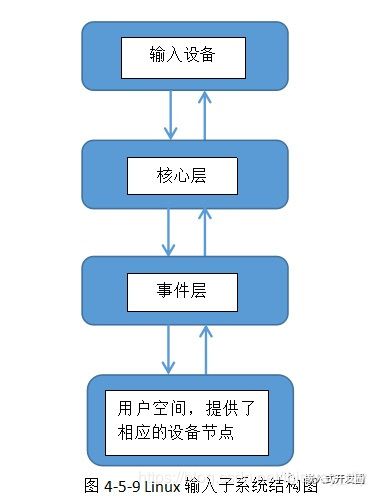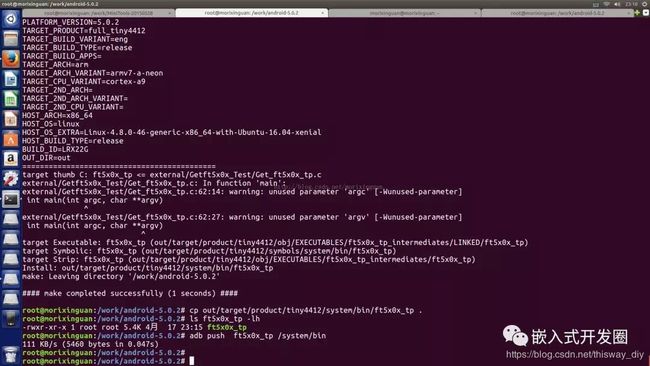作者:杨源鑫(也是我们的校园代理)
经授权转载于公众号嵌入式开发圈,有些许修改。
什么是input子系统?不管是什么操作系统,都有一个程序用于管理各种输入设备,哪些是输入设备?比如,电脑键盘、鼠标,智能手机上的触摸屏,按键。都是输入设备。那么操作系统怎么管理这些输入设备?这里以最常用的Linux操作系统进行讲解。
在Linux内核中,有非常多用于管理诸多设备的子系统,比如显示系统,输入子系统,音频子系统,电源管理子系统,时钟管理子系统等等,本节我们重点关注输入子系统。
输入子系统是在内核里实现,因为设备经常要通过特定的硬件接口被访问 (例如串口, ps/2, usb等等 ),这些硬件接口由内核保护和管理。内核给用户导出一套固定的与硬件无关的 input API,供用户空间程序使用。
在Linux input子系统中,分三块进行管理,分别是: input core(输入系统核心层), drivers(输入系统驱动层)和 event handlers(输入系统事件层),可能你感觉太抽象,看下图4-5-9就清楚了。
先从应用程序角度认识input子系统,我们可以从以下这个文件看到对应的设备。
打开Linux终端,输入命令cat /proc/bus/input/devices可以看到类似下面的内容。
I: Bus=0003 Vendor=046d Product=c018 Version=0111
N: Name=" USB Optical Mouse"
P: Phys=usb-0000:00:1d.1-2/input0
S: Sysfs=/class/input/input24
U: Uniq=
H: Handlers=mouse1 event2
B: EV=7
B: KEY=70000 0 0 0 0 0 0 0 0
B: REL=103
这些devices主要是用来描述注册在input子系统的设备文件,可能有鼠标,键盘,触摸屏,重力传感器,温度传感器等等,写驱动的时候,通过内核提供的input设备注册设备相关的接口后,这些信息都会保存到对应的文件里。
那么,input子系统如何描述输入设备呢?
Linux系统为我们提供了这个输入系统操作相关的头文件:
include
在这个文件中,可以找到这个结构体:
//用于描述一个输入事件
struct input_event {
struct timeval time;
__u16 type;
__u16 code;
__s32 value;
};
在这里我们看到input_event结构体中还嵌套了另一个结构体struct timeval time;
先解读struct timeval time,它在time.h中定义如下
struct timeval
{
__time_t tv_sec; /* Seconds. */
__suseconds_t tv_usec; /*Microseconds. */
};
其中,tv_sec为Epoch到创建struct timeval时的秒数,tv_usec为微秒数,即秒后面的零头。
type域是被报告事件的类型,例如,一个 key press或者 button press, relative motion(比如移动鼠标 )或者 absolute motion(比如移动游戏杆 );
code域告诉你是哪一个key或者坐标轴在被操作;
value域告诉你设备现在的状态或者运动情况是什么。
最主要的事件有以下三种: 相对事件(例如鼠标),绝对事件(例如触摸屏),键盘事件。
例如鼠标,我们在移动鼠标的时候鼠标就是一个相对事件,所以type的类型也就是底层上报给用户的事件为相对事件类型,code表示的就是相对于鼠标当前的位置的X或者Y的坐标,value也就是相对于当前的位置偏移了多少。
事件类型(type)在input.h分类如下:
/*
* Event types
*/
#define EV_SYN 0x00 //同步事件,就是将结果上报给系统的过程
#define EV_KEY 0x01 //按键事件
#define EV_REL 0x02 //相对事件
#define EV_ABS 0x03 //绝对事件
本节,我们来实现一个input控制鼠标的应用程序。所以还会用到以下事件:
/*
* Relative axes
*/
//在这里,我们暂时只会用REL_X和REL_Y这两个参数
#define REL_X 0x00 //相对X坐标
#define REL_Y 0x01 //相对Y坐标
我们可以使用cat命令来测试当前的鼠标事件到底属于哪一个事件节点,如图4-5-10所示:

只需切换到/dev/input,找到对应的事件节点,再使用cat eventx(事件节点),然后移动鼠标就可以看到数据打印啦,但是这些数据我们显然是看不懂的,不过可以使用测试程序将鼠标的值读出来。
接下来,我们写个程序mouse.c来看看如何读取鼠标事件,
#include
#include
#include
#include
#include
/*
struct input_event {
struct timeval time;
__u16 type;
__u16 code;
__s32 value;
};
*/
/*
Event types
#define EV_SYN 0x00
#define EV_KEY 0x01
#define EV_REL 0x02
#define EV_ABS 0x03
*/
/*
Relative axes
#define REL_X 0x00
#define REL_Y 0x01
#define REL_Z 0x02
#define REL_MAX 0x0f
#define REL_CNT (REL_MAX+1)
*/
//event8 mouse
//event9 keyboard
int main(void)
{
//1、定义一个结构体变量用来描述input事件
struct input_event event_mouse ;
//2、打开input设备的事件节点我的电脑对应的鼠标事件的节点是event3
//读者的电脑的设备节点可能和我的不一样,可以使用cat命令去获取,然后
//不断尝试
int fd = open("/dev/input/event4",O_RDWR);
int value ;
int type ;
int buffer[10]={0};
if(-1 == fd){
printf("open mouse event fair!\n");
return -1 ;
}
while(1){
//3、读事件
read(fd ,&event_mouse ,sizeof(event_mouse));
//4、判断事件类型,并打印键码
switch(event_mouse.type){
//同步事件
case EV_SYN:
printf("sync!\n");
break ;
case EV_REL:
//鼠标事件,XY相对位移
//code表示相对位移X或者Y,当判断是X时,打印X的相对位移value
//当判断是Y时,打印Y的相对位移value
if(event_mouse.code == REL_X){
printf("event_mouse.code_X:%d\n",event_mouse.code);
printf("event_mouse.value_X:%d\n",event_mouse.value);
}
if(event_mouse.code == REL_Y){
printf("event_mouse.code_Y:%d\n",event_mouse.code);
printf("event_mouse.value_Y:%d\n",event_mouse.value);
}
defalut:
break ;
}
}
return 0 ;
}
运行结果,如图4-5-11所示。

当我们不断移动鼠标的时候,这些值将会被打印出来。
请思考一个问题,既然我们移动鼠标能够打印数值,那能不能够写一个程序控制鼠标自动移动呢?肯定可以,下面我们写个程序让鼠标自己画一个正方形,上代码:
#include
#include
#include
#include
#include
//event8 mouse
//event9 keyboard
int main(void)
{
//1、定义一个结构体变量用来描述input事件
struct input_event event_mouse ;
//2、打开input设备的事件节点 我的电脑鼠标事件的节点是event3
int fd = open("/dev/input/event3",O_RDWR);
int value ;
int type ;
int i ;
int buffer[10]={0};
if(-1 == fd){
printf("open mouse event fair!\n");
return -1 ;
}
while(1){
//3、写事件
for(i = 0 ; i < 20 ; i++){
event_mouse.type = EV_REL ;
event_mouse.code = REL_X ;
event_mouse.value = i ;
write(fd,&event_mouse,sizeof(event_mouse));
event_mouse.code = 0 ;
event_mouse.value = 0;
event_mouse.type = EV_SYN ;
write(fd,&event_mouse,sizeof(event_mouse));
usleep(50000);
}
for(i = 0 ; i < 20 ; i++){
event_mouse.type = EV_REL ;
event_mouse.code = REL_Y ;
event_mouse.value = i ;
write(fd,&event_mouse,sizeof(event_mouse));
event_mouse.code = 0 ;
event_mouse.value = 0 ;
event_mouse.type = EV_SYN ;
write(fd,&event_mouse,sizeof(event_mouse));
usleep(50000);
}
for(i = 0 ; i > -20 ; i--){
event_mouse.type = EV_REL ;
event_mouse.code = REL_X ;
event_mouse.value = i ;
write(fd,&event_mouse,sizeof(event_mouse));
event_mouse.code = 0 ;
event_mouse.value = 0;
event_mouse.type = EV_SYN ;
write(fd,&event_mouse,sizeof(event_mouse));
usleep(50000);
}
for(i = 0 ; i > -20 ; i--){
event_mouse.type = EV_REL ;
event_mouse.code = REL_Y ;
event_mouse.value = i ;
write(fd,&event_mouse,sizeof(event_mouse));
event_mouse.code = 0 ;
event_mouse.value = 0 ;
event_mouse.type = EV_SYN ;
write(fd,&event_mouse,sizeof(event_mouse));
usleep(50000);
}
}
return 0 ;
}
执行效果请读者自行验证。
接下来我们再写一个案例:在Tiny4412平台上获取电容屏的坐标值。
触摸屏上报坐标值的事件属于绝对事件,也就是,触摸的坐标点X和Y会在屏幕的分辨率范围内上报一个绝对的坐标(X,Y)。
那么上报对于的类型(type)如下:EV_ABS
对于的code如下:
绝对于X:
ABS_MT_POSITION_X
绝对于Y:
ABS_MT_POSITION_Y
我用了一个程序获取了屏幕的分辨率,得知分辨率宽为480,高为800。
首先,写这个程序时,我通过adb进到Android根目录,然后用getevent -p查到触摸屏的事件节点为event0, 同时也知道触摸屏是一个绝对事件,如下:

接下来,我在Android5.0的源代码external目录下创建了如下目录:Getft5x0x_Test
该目录下有如下两个文件文件:
Android.mk和Get_ft5x0x_tp.c
(1) 先看Android.mk
LOCAL_PATH := $(call my-dir)
include $(CLEAR_VARS)
LOCAL_MODULE_TAGS := eng
LOCAL_SHARED_LIBRARIES += libcutils libutils
#LOCAL_STATIC_LIBRARIES += libz libstdc++ libpng libvtpng
LOCAL_STATIC_LIBRARIES += libz libstdc++ libpng
LOCAL_SRC_FILES := Get_ft5x0x_tp.c
LOCAL_MODULE := ft5x0x_tp
include $(BUILD_EXECUTABLE)
(2)Get_ft5x0x_tp.c
#include
#include
#include
#include
#include
#include
#include
#include
#include
#include
#include
#include
#include
#include
#include
#include
//ft5x0x_ts触摸屏事件初始化
18int touch_fd = -1 ;
19int ft5x0x_ts__init(void)
{
touch_fd = open("/dev/input/event0", O_RDONLY);
if (touch_fd < 0)
{
printf("open /dev/input/event0 failed\n");
return -1;
}
return 0;
}
//获取ft5x0x_ts触摸屏上的坐标点
int Get_ft5x0x_ts_postion(int *x, int *y)
{
int touch_ret = -1 ;
//1、定义一个结构体变量用来描述ft5x0x触摸屏事件
struct input_event ft5x0x_ts ;
//2、读事件
touch_ret = read(touch_fd ,&ft5x0x_ts ,sizeof(ft5x0x_ts));
if(touch_ret < 0){
printf("read touch fair!\n");
}
//3、判断事件类型
switch(ft5x0x_ts.type)
{
case EV_SYN:
break ;
case EV_ABS:
if(ft5x0x_ts.code == ABS_MT_POSITION_X){
*x = ft5x0x_ts.value ;
}
if(ft5x0x_ts.code == ABS_MT_POSITION_Y){
*y = ft5x0x_ts.value ;
}
defalut:
break ;
}
return 0;
}
int main(int argc, char **argv)
{
int tp_ret ;
int ft5x0x_x = 0;
int ft5x0x_y = 0;
tp_ret = ft5x0x_ts__init();
if(-1 == tp_ret){
printf("tp init fair!\n");
return -1 ;
}
printf("tp init success!\n");
while(1)
{ //获取屏幕上的绝对坐标点
Get_ft5x0x_ts_postion(&ft5x0x_x,&ft5x0x_y);
printf("ft5x0x_x:%d ft5x0x_y:%d\n",ft5x0x_x,ft5x0x_y);
usleep(100);
}
return 0;
}
编写完Android.mk和C程序后,切换到Android的根目录,用以下命令编译Get_ft5x0x_tp.c
(使用mmm命令之前一定要先执行source和lunch这两个步骤)
root@morixinguan:/work/android-5.0.2# source build/envsetup.sh
including device/samsung/manta/vendorsetup.sh
including device/moto/shamu/vendorsetup.sh
including device/friendly-arm/tiny4412/vendorsetup.sh
including device/generic/mini-emulator-x86_64/vendorsetup.sh
including device/generic/mini-emulator-armv7-a-neon/vendorsetup.sh
including device/generic/mini-emulator-mips/vendorsetup.sh
including device/generic/mini-emulator-arm64/vendorsetup.sh
including device/generic/mini-emulator-x86/vendorsetup.sh
including device/asus/deb/vendorsetup.sh
including device/asus/fugu/vendorsetup.sh
including device/asus/grouper/vendorsetup.sh
including device/asus/tilapia/vendorsetup.sh
including device/asus/flo/vendorsetup.sh
including device/lge/hammerhead/vendorsetup.sh
including device/lge/mako/vendorsetup.sh
including sdk/bash_completion/adb.bash
root@morixinguan:/work/android-5.0.2# lunch
You're building on Linux
Lunch menu... pick a combo:
. aosp_arm-eng
. aosp_arm64-eng
. aosp_mips-eng
. aosp_mips64-eng
. aosp_x86-eng
. aosp_x86_64-eng
. aosp_manta-userdebug
. aosp_shamu-userdebug
. full_tiny4412-userdebug
. full_tiny4412-eng
. mini_emulator_x86_64-userdebug
. m_e_arm-userdebug
. mini_emulator_mips-userdebug
. mini_emulator_arm64-userdebug
. mini_emulator_x86-userdebug
. aosp_deb-userdebug
. full_fugu-userdebug
. aosp_fugu-userdebug
. aosp_grouper-userdebug
. aosp_tilapia-userdebug
. aosp_flo-userdebug
. aosp_hammerhead-userdebug
. aosp_mako-userdebug
Which would you like? [aosp_arm-eng] 20
============================================
PLATFORM_VERSION_CODENAME=REL
PLATFORM_VERSION=5.0.2
TARGET_PRODUCT=aosp_tilapia
TARGET_BUILD_VARIANT=userdebug
TARGET_BUILD_TYPE=release
TARGET_BUILD_APPS=
TARGET_ARCH=arm
TARGET_ARCH_VARIANT=armv7-a-neon
TARGET_CPU_VARIANT=cortex-a9
TARGET_2ND_ARCH=
TARGET_2ND_ARCH_VARIANT=
TARGET_2ND_CPU_VARIANT=
HOST_ARCH=x86_64
HOST_OS=linux
HOST_OS_EXTRA=Linux-4.8.0-46-generic-x86_64-with-Ubuntu-16.04-xenial
HOST_BUILD_TYPE=release
BUILD_ID=LRX22G
OUT_DIR=out
====================
root@morixinguan:/work/android-5.0.2#
接下来,编译程序 :
mmm external/Getft5x0x_Test/
这个二进制生成的绝对路径是out目录, 我们需要ft5x0x_tp文件,这个名字就是上面Android.mk里面对应的:
LOCAL_MODULE := ft5x0x_tp
Install: out/target/product/tiny4412/system/bin/ft5x0x_tp
将这个文件拷贝到当前目录:
cp out/target/product/tiny4412/system/bin/ft5x0x_tp .
然后,用USB线连接tiny4412开发板,再用adb命令将ft5x0x_tp push到system/bin/目录下,这个目录是Android的根文件系统下的一个命令,很多命令都在这个目录下。
(若没有安装adb,可以apt-get install adb 进行安装)
adb push完毕以后,再adb shell切换到根目录下
执行ft5x0x_tp.bin,然后触摸触摸屏,这样,坐标值就打印出来了。

ps:韦东山2期视频对输入子系统的驱动编写以及机制讲解的很清楚,有需要的可以看看
--END--
关注公众号百问科技(ID:baiwenkeji)第一时间阅读嵌入式干货。
技术交流加个人威信13266630429,验证:博客园

